HA3042 Taxation Law Assignment: Fringe Benefits Tax and CGT
VerifiedAdded on 2022/11/14
|9
|2360
|71
Homework Assignment
AI Summary
This taxation law assignment, prepared by a student, addresses two key areas of Australian tax law: Fringe Benefits Tax (FBT) and Capital Gains Tax (CGT). The first part focuses on calculating the FBT liability for Spiceco Pty Ltd concerning a car fringe benefit provided to an employee, Lucinda. The calculation involves determining depreciation, interest, operating costs, and taxable value using statutory formulas and cost basis techniques. The final FBT liability is computed after considering the grossed-up value and applicable tax rates. The second part of the assignment examines the Capital Gains Tax (CGT) implications for Daniel, who disposed of several assets, including a house, painting, luxury yacht, and BHP shares. The analysis covers the main residence exemption, treatment of collectibles, personal use assets, and shares, including cost base calculations. The assignment concludes with a discussion of potential capital gains or losses, the 50% discount method, and the application of CGT at the marginal rate, along with the possibility of offsetting capital losses and carrying them forward. References to relevant sections of the FBTAA 1986 and ITAA 1997 are included.
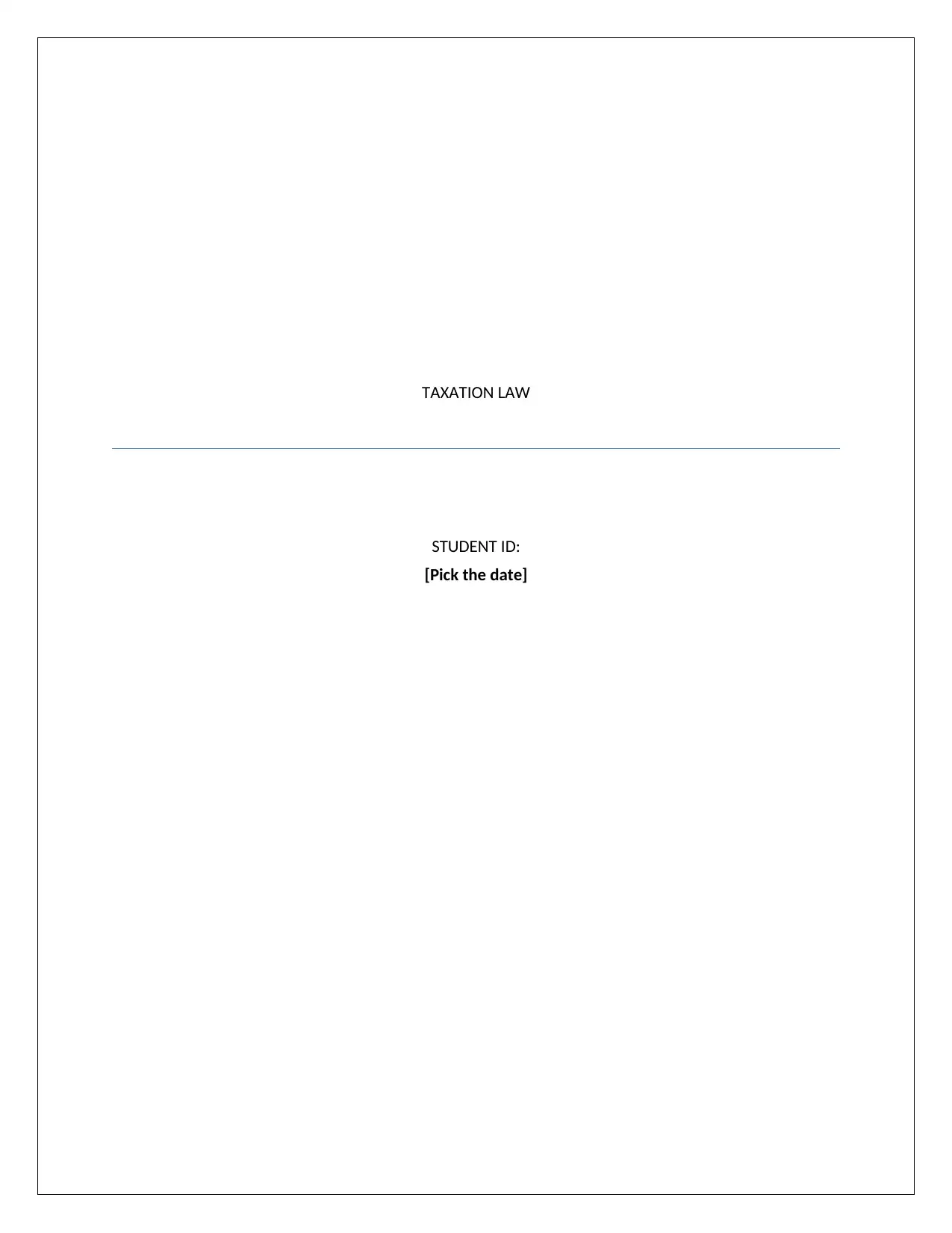
TAXATION LAW
STUDENT ID:
[Pick the date]
STUDENT ID:
[Pick the date]
Paraphrase This Document
Need a fresh take? Get an instant paraphrase of this document with our AI Paraphraser
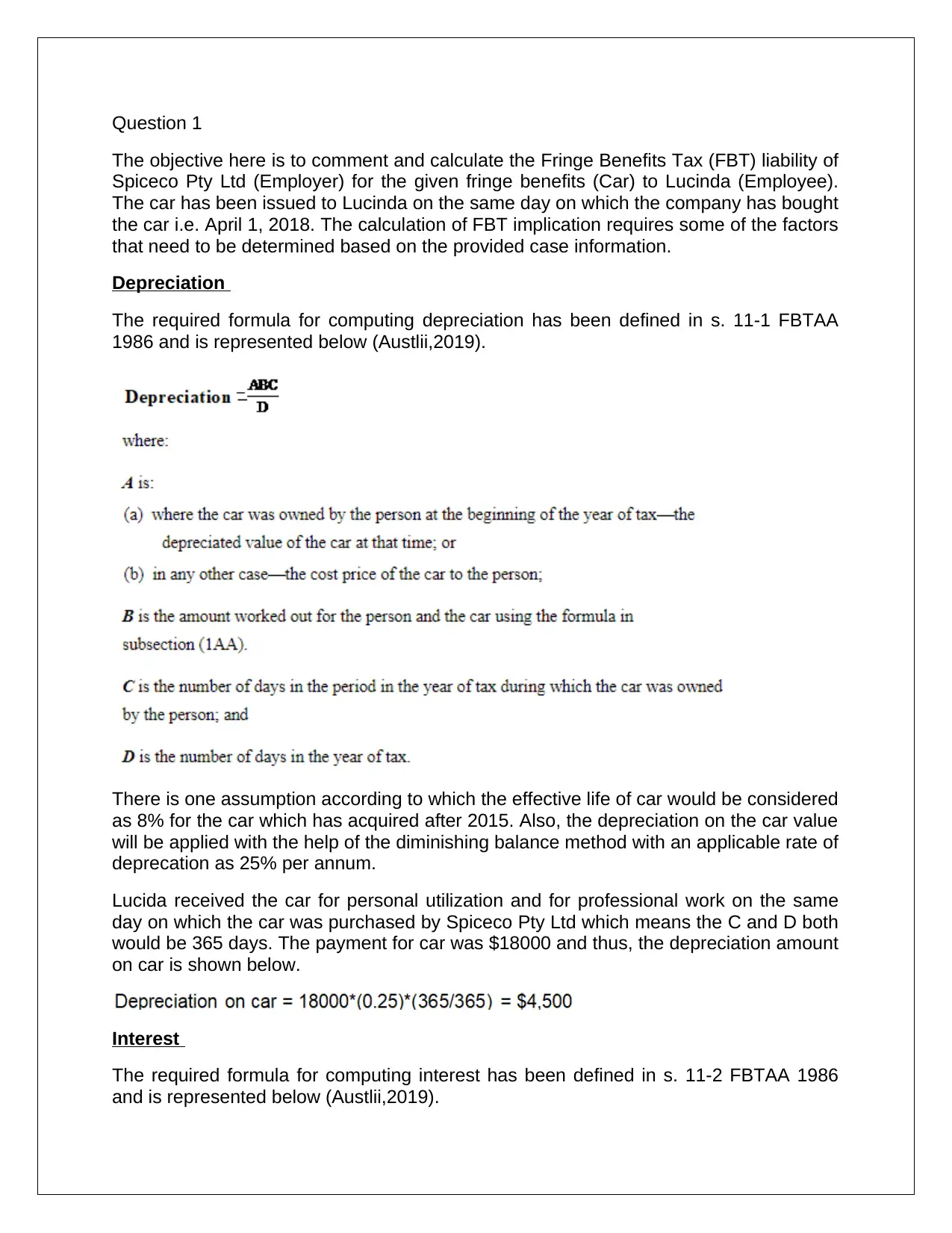
Question 1
The objective here is to comment and calculate the Fringe Benefits Tax (FBT) liability of
Spiceco Pty Ltd (Employer) for the given fringe benefits (Car) to Lucinda (Employee).
The car has been issued to Lucinda on the same day on which the company has bought
the car i.e. April 1, 2018. The calculation of FBT implication requires some of the factors
that need to be determined based on the provided case information.
Depreciation
The required formula for computing depreciation has been defined in s. 11-1 FBTAA
1986 and is represented below (Austlii,2019).
There is one assumption according to which the effective life of car would be considered
as 8% for the car which has acquired after 2015. Also, the depreciation on the car value
will be applied with the help of the diminishing balance method with an applicable rate of
deprecation as 25% per annum.
Lucida received the car for personal utilization and for professional work on the same
day on which the car was purchased by Spiceco Pty Ltd which means the C and D both
would be 365 days. The payment for car was $18000 and thus, the depreciation amount
on car is shown below.
Interest
The required formula for computing interest has been defined in s. 11-2 FBTAA 1986
and is represented below (Austlii,2019).
The objective here is to comment and calculate the Fringe Benefits Tax (FBT) liability of
Spiceco Pty Ltd (Employer) for the given fringe benefits (Car) to Lucinda (Employee).
The car has been issued to Lucinda on the same day on which the company has bought
the car i.e. April 1, 2018. The calculation of FBT implication requires some of the factors
that need to be determined based on the provided case information.
Depreciation
The required formula for computing depreciation has been defined in s. 11-1 FBTAA
1986 and is represented below (Austlii,2019).
There is one assumption according to which the effective life of car would be considered
as 8% for the car which has acquired after 2015. Also, the depreciation on the car value
will be applied with the help of the diminishing balance method with an applicable rate of
deprecation as 25% per annum.
Lucida received the car for personal utilization and for professional work on the same
day on which the car was purchased by Spiceco Pty Ltd which means the C and D both
would be 365 days. The payment for car was $18000 and thus, the depreciation amount
on car is shown below.
Interest
The required formula for computing interest has been defined in s. 11-2 FBTAA 1986
and is represented below (Austlii,2019).
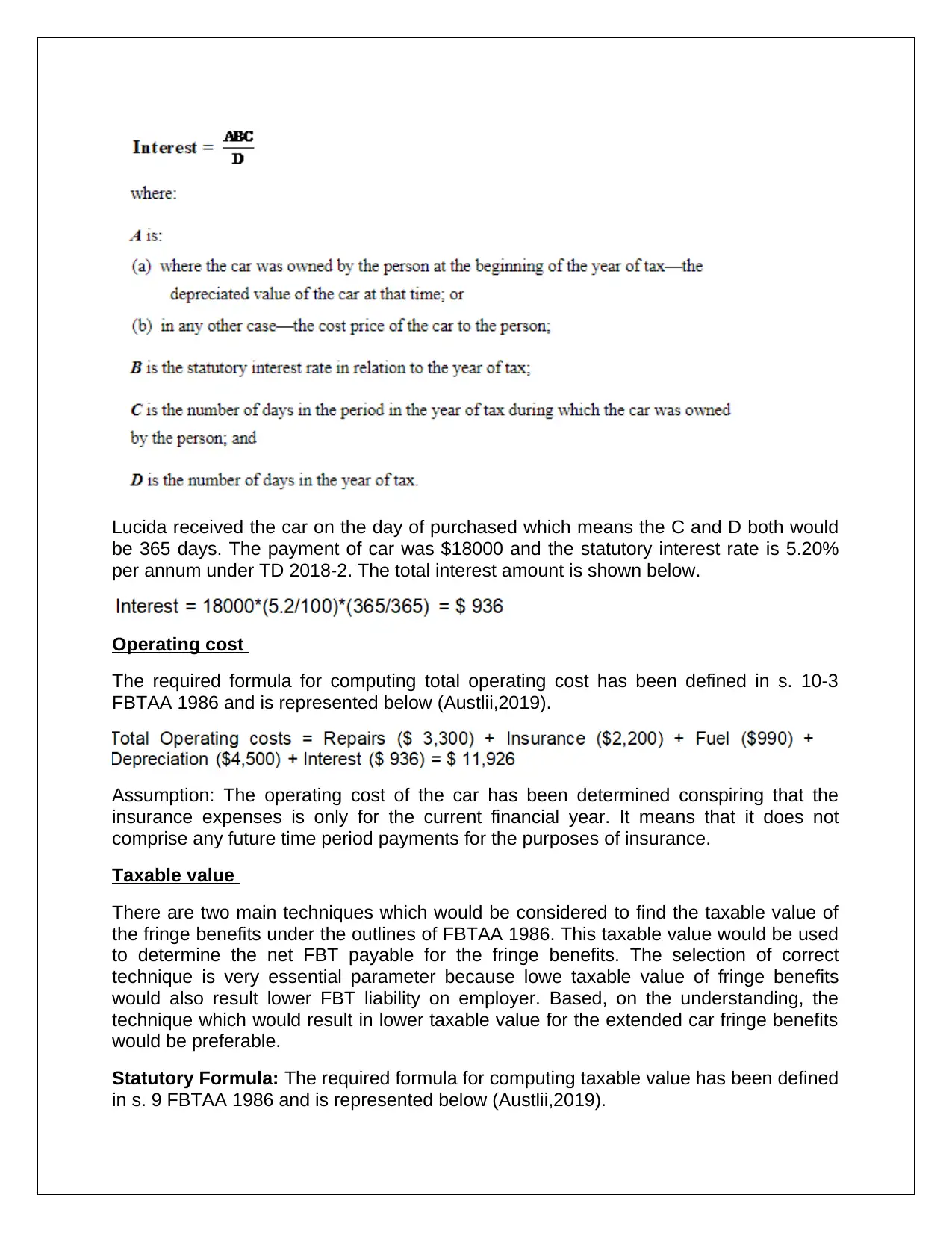
Lucida received the car on the day of purchased which means the C and D both would
be 365 days. The payment of car was $18000 and the statutory interest rate is 5.20%
per annum under TD 2018-2. The total interest amount is shown below.
Operating cost
The required formula for computing total operating cost has been defined in s. 10-3
FBTAA 1986 and is represented below (Austlii,2019).
Assumption: The operating cost of the car has been determined conspiring that the
insurance expenses is only for the current financial year. It means that it does not
comprise any future time period payments for the purposes of insurance.
Taxable value
There are two main techniques which would be considered to find the taxable value of
the fringe benefits under the outlines of FBTAA 1986. This taxable value would be used
to determine the net FBT payable for the fringe benefits. The selection of correct
technique is very essential parameter because lowe taxable value of fringe benefits
would also result lower FBT liability on employer. Based, on the understanding, the
technique which would result in lower taxable value for the extended car fringe benefits
would be preferable.
Statutory Formula: The required formula for computing taxable value has been defined
in s. 9 FBTAA 1986 and is represented below (Austlii,2019).
be 365 days. The payment of car was $18000 and the statutory interest rate is 5.20%
per annum under TD 2018-2. The total interest amount is shown below.
Operating cost
The required formula for computing total operating cost has been defined in s. 10-3
FBTAA 1986 and is represented below (Austlii,2019).
Assumption: The operating cost of the car has been determined conspiring that the
insurance expenses is only for the current financial year. It means that it does not
comprise any future time period payments for the purposes of insurance.
Taxable value
There are two main techniques which would be considered to find the taxable value of
the fringe benefits under the outlines of FBTAA 1986. This taxable value would be used
to determine the net FBT payable for the fringe benefits. The selection of correct
technique is very essential parameter because lowe taxable value of fringe benefits
would also result lower FBT liability on employer. Based, on the understanding, the
technique which would result in lower taxable value for the extended car fringe benefits
would be preferable.
Statutory Formula: The required formula for computing taxable value has been defined
in s. 9 FBTAA 1986 and is represented below (Austlii,2019).
⊘ This is a preview!⊘
Do you want full access?
Subscribe today to unlock all pages.

Trusted by 1+ million students worldwide
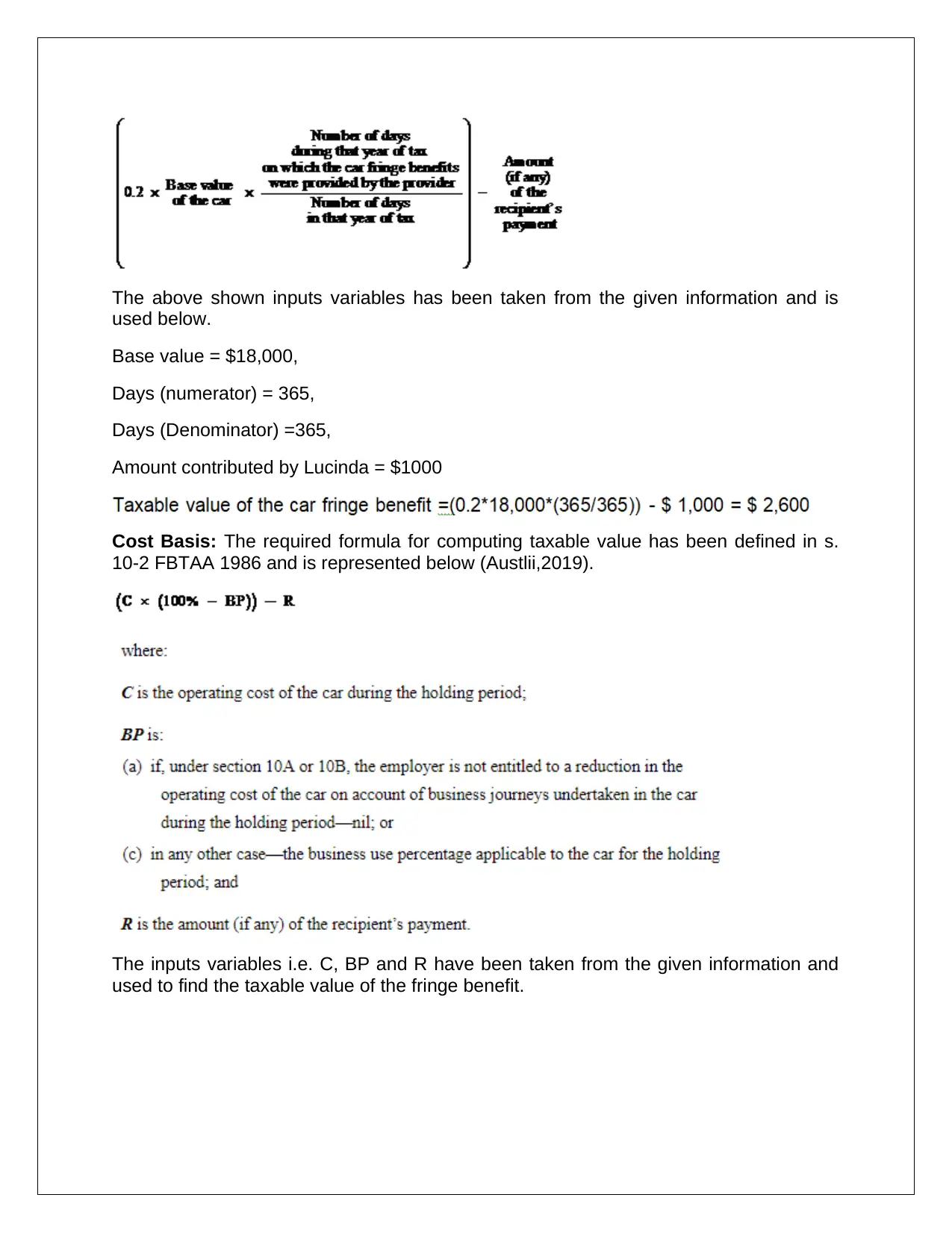
The above shown inputs variables has been taken from the given information and is
used below.
Base value = $18,000,
Days (numerator) = 365,
Days (Denominator) =365,
Amount contributed by Lucinda = $1000
Cost Basis: The required formula for computing taxable value has been defined in s.
10-2 FBTAA 1986 and is represented below (Austlii,2019).
The inputs variables i.e. C, BP and R have been taken from the given information and
used to find the taxable value of the fringe benefit.
used below.
Base value = $18,000,
Days (numerator) = 365,
Days (Denominator) =365,
Amount contributed by Lucinda = $1000
Cost Basis: The required formula for computing taxable value has been defined in s.
10-2 FBTAA 1986 and is represented below (Austlii,2019).
The inputs variables i.e. C, BP and R have been taken from the given information and
used to find the taxable value of the fringe benefit.
Paraphrase This Document
Need a fresh take? Get an instant paraphrase of this document with our AI Paraphraser
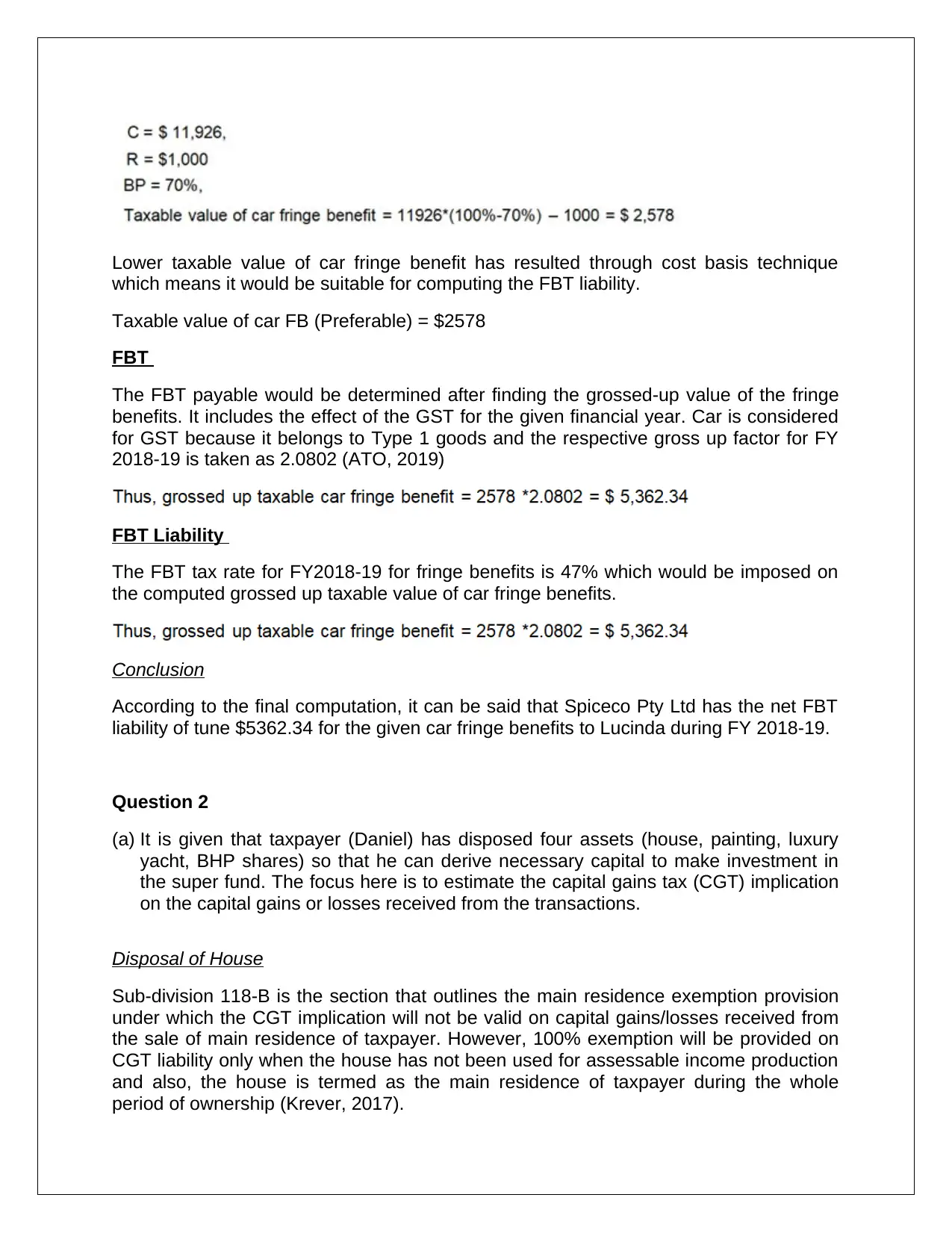
Lower taxable value of car fringe benefit has resulted through cost basis technique
which means it would be suitable for computing the FBT liability.
Taxable value of car FB (Preferable) = $2578
FBT
The FBT payable would be determined after finding the grossed-up value of the fringe
benefits. It includes the effect of the GST for the given financial year. Car is considered
for GST because it belongs to Type 1 goods and the respective gross up factor for FY
2018-19 is taken as 2.0802 (ATO, 2019)
FBT Liability
The FBT tax rate for FY2018-19 for fringe benefits is 47% which would be imposed on
the computed grossed up taxable value of car fringe benefits.
Conclusion
According to the final computation, it can be said that Spiceco Pty Ltd has the net FBT
liability of tune $5362.34 for the given car fringe benefits to Lucinda during FY 2018-19.
Question 2
(a) It is given that taxpayer (Daniel) has disposed four assets (house, painting, luxury
yacht, BHP shares) so that he can derive necessary capital to make investment in
the super fund. The focus here is to estimate the capital gains tax (CGT) implication
on the capital gains or losses received from the transactions.
Disposal of House
Sub-division 118-B is the section that outlines the main residence exemption provision
under which the CGT implication will not be valid on capital gains/losses received from
the sale of main residence of taxpayer. However, 100% exemption will be provided on
CGT liability only when the house has not been used for assessable income production
and also, the house is termed as the main residence of taxpayer during the whole
period of ownership (Krever, 2017).
which means it would be suitable for computing the FBT liability.
Taxable value of car FB (Preferable) = $2578
FBT
The FBT payable would be determined after finding the grossed-up value of the fringe
benefits. It includes the effect of the GST for the given financial year. Car is considered
for GST because it belongs to Type 1 goods and the respective gross up factor for FY
2018-19 is taken as 2.0802 (ATO, 2019)
FBT Liability
The FBT tax rate for FY2018-19 for fringe benefits is 47% which would be imposed on
the computed grossed up taxable value of car fringe benefits.
Conclusion
According to the final computation, it can be said that Spiceco Pty Ltd has the net FBT
liability of tune $5362.34 for the given car fringe benefits to Lucinda during FY 2018-19.
Question 2
(a) It is given that taxpayer (Daniel) has disposed four assets (house, painting, luxury
yacht, BHP shares) so that he can derive necessary capital to make investment in
the super fund. The focus here is to estimate the capital gains tax (CGT) implication
on the capital gains or losses received from the transactions.
Disposal of House
Sub-division 118-B is the section that outlines the main residence exemption provision
under which the CGT implication will not be valid on capital gains/losses received from
the sale of main residence of taxpayer. However, 100% exemption will be provided on
CGT liability only when the house has not been used for assessable income production
and also, the house is termed as the main residence of taxpayer during the whole
period of ownership (Krever, 2017).
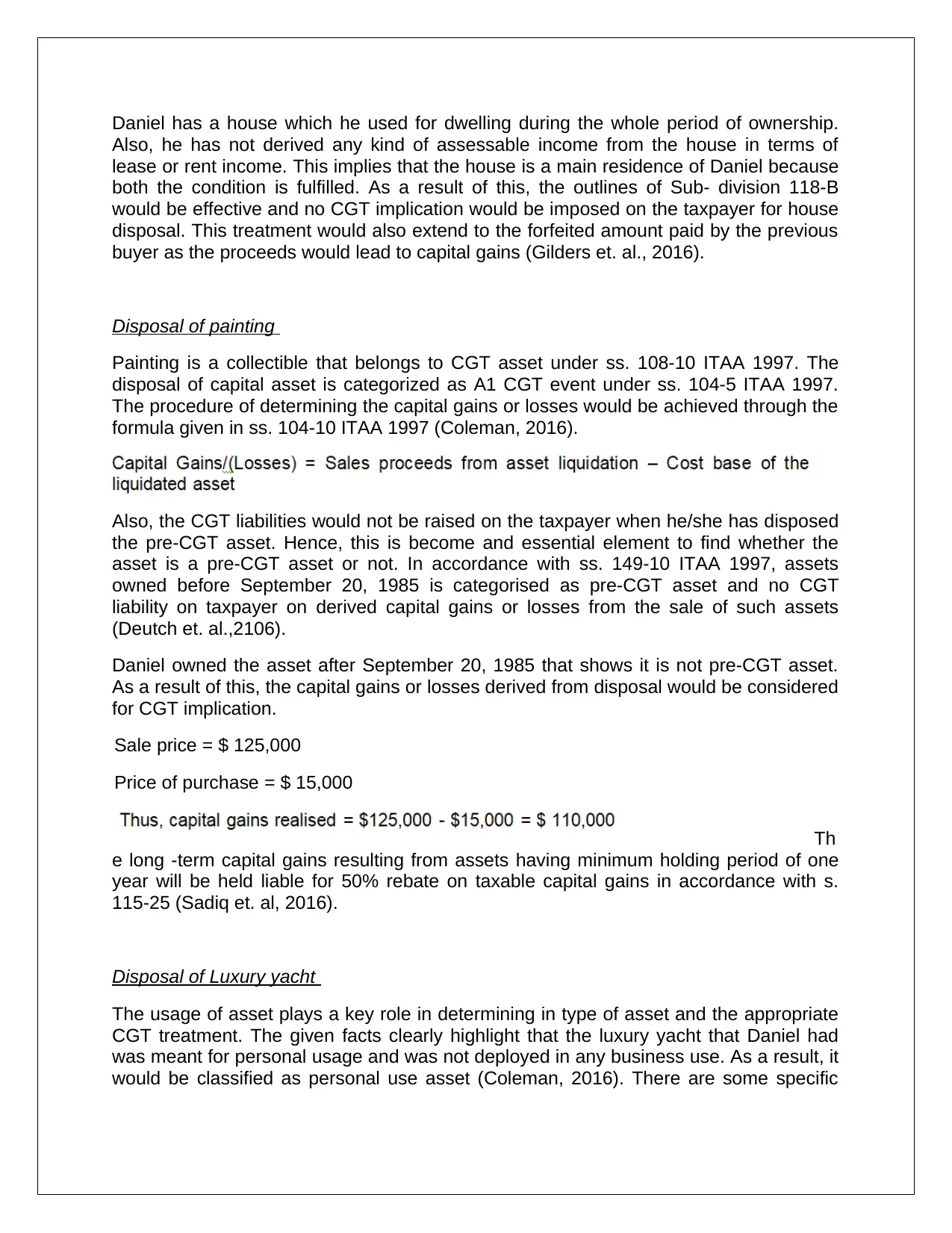
Daniel has a house which he used for dwelling during the whole period of ownership.
Also, he has not derived any kind of assessable income from the house in terms of
lease or rent income. This implies that the house is a main residence of Daniel because
both the condition is fulfilled. As a result of this, the outlines of Sub- division 118-B
would be effective and no CGT implication would be imposed on the taxpayer for house
disposal. This treatment would also extend to the forfeited amount paid by the previous
buyer as the proceeds would lead to capital gains (Gilders et. al., 2016).
Disposal of painting
Painting is a collectible that belongs to CGT asset under ss. 108-10 ITAA 1997. The
disposal of capital asset is categorized as A1 CGT event under ss. 104-5 ITAA 1997.
The procedure of determining the capital gains or losses would be achieved through the
formula given in ss. 104-10 ITAA 1997 (Coleman, 2016).
Also, the CGT liabilities would not be raised on the taxpayer when he/she has disposed
the pre-CGT asset. Hence, this is become and essential element to find whether the
asset is a pre-CGT asset or not. In accordance with ss. 149-10 ITAA 1997, assets
owned before September 20, 1985 is categorised as pre-CGT asset and no CGT
liability on taxpayer on derived capital gains or losses from the sale of such assets
(Deutch et. al.,2106).
Daniel owned the asset after September 20, 1985 that shows it is not pre-CGT asset.
As a result of this, the capital gains or losses derived from disposal would be considered
for CGT implication.
Sale price = $ 125,000
Price of purchase = $ 15,000
Th
e long -term capital gains resulting from assets having minimum holding period of one
year will be held liable for 50% rebate on taxable capital gains in accordance with s.
115-25 (Sadiq et. al, 2016).
Disposal of Luxury yacht
The usage of asset plays a key role in determining in type of asset and the appropriate
CGT treatment. The given facts clearly highlight that the luxury yacht that Daniel had
was meant for personal usage and was not deployed in any business use. As a result, it
would be classified as personal use asset (Coleman, 2016). There are some specific
Also, he has not derived any kind of assessable income from the house in terms of
lease or rent income. This implies that the house is a main residence of Daniel because
both the condition is fulfilled. As a result of this, the outlines of Sub- division 118-B
would be effective and no CGT implication would be imposed on the taxpayer for house
disposal. This treatment would also extend to the forfeited amount paid by the previous
buyer as the proceeds would lead to capital gains (Gilders et. al., 2016).
Disposal of painting
Painting is a collectible that belongs to CGT asset under ss. 108-10 ITAA 1997. The
disposal of capital asset is categorized as A1 CGT event under ss. 104-5 ITAA 1997.
The procedure of determining the capital gains or losses would be achieved through the
formula given in ss. 104-10 ITAA 1997 (Coleman, 2016).
Also, the CGT liabilities would not be raised on the taxpayer when he/she has disposed
the pre-CGT asset. Hence, this is become and essential element to find whether the
asset is a pre-CGT asset or not. In accordance with ss. 149-10 ITAA 1997, assets
owned before September 20, 1985 is categorised as pre-CGT asset and no CGT
liability on taxpayer on derived capital gains or losses from the sale of such assets
(Deutch et. al.,2106).
Daniel owned the asset after September 20, 1985 that shows it is not pre-CGT asset.
As a result of this, the capital gains or losses derived from disposal would be considered
for CGT implication.
Sale price = $ 125,000
Price of purchase = $ 15,000
Th
e long -term capital gains resulting from assets having minimum holding period of one
year will be held liable for 50% rebate on taxable capital gains in accordance with s.
115-25 (Sadiq et. al, 2016).
Disposal of Luxury yacht
The usage of asset plays a key role in determining in type of asset and the appropriate
CGT treatment. The given facts clearly highlight that the luxury yacht that Daniel had
was meant for personal usage and was not deployed in any business use. As a result, it
would be classified as personal use asset (Coleman, 2016). There are some specific
⊘ This is a preview!⊘
Do you want full access?
Subscribe today to unlock all pages.

Trusted by 1+ million students worldwide
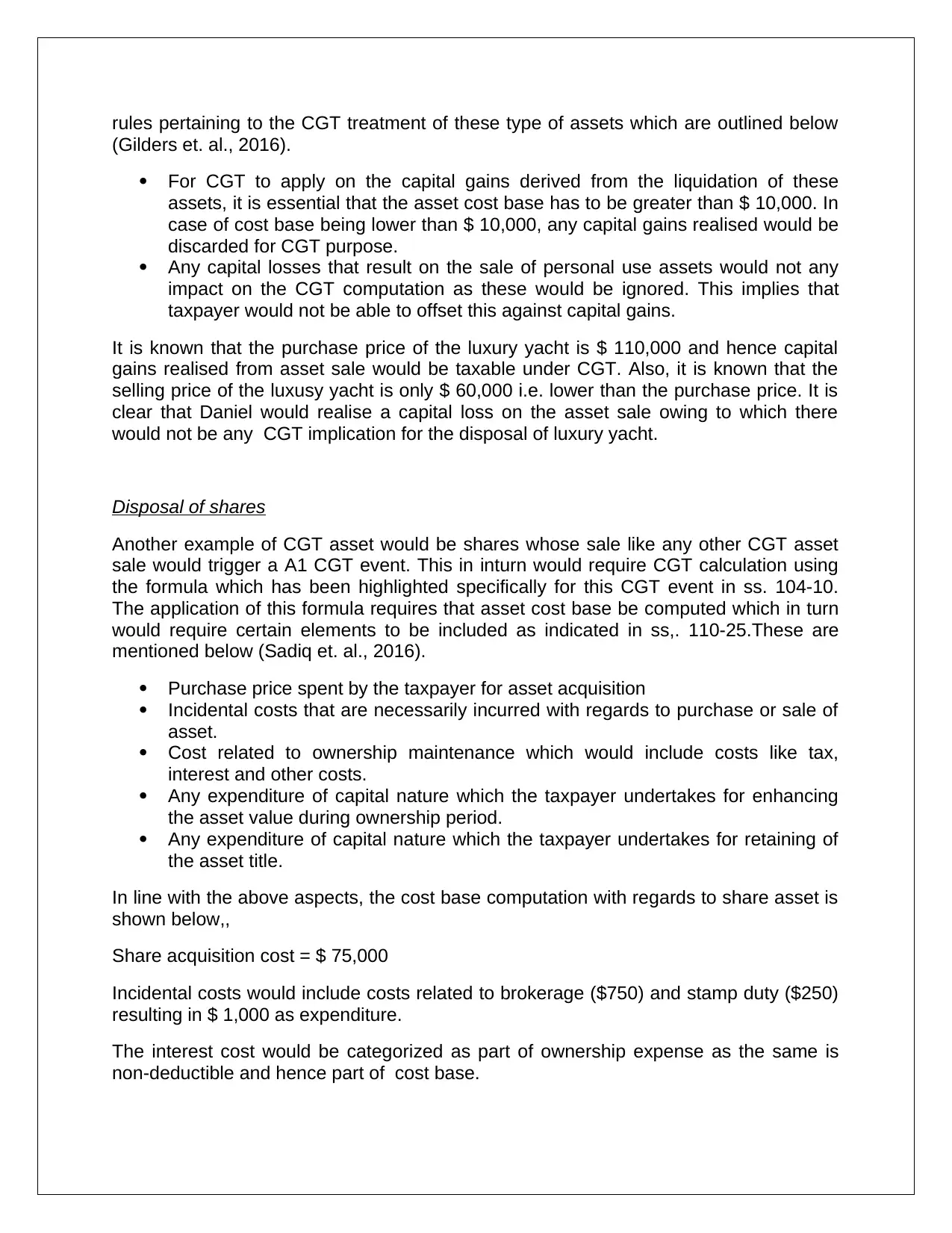
rules pertaining to the CGT treatment of these type of assets which are outlined below
(Gilders et. al., 2016).
For CGT to apply on the capital gains derived from the liquidation of these
assets, it is essential that the asset cost base has to be greater than $ 10,000. In
case of cost base being lower than $ 10,000, any capital gains realised would be
discarded for CGT purpose.
Any capital losses that result on the sale of personal use assets would not any
impact on the CGT computation as these would be ignored. This implies that
taxpayer would not be able to offset this against capital gains.
It is known that the purchase price of the luxury yacht is $ 110,000 and hence capital
gains realised from asset sale would be taxable under CGT. Also, it is known that the
selling price of the luxusy yacht is only $ 60,000 i.e. lower than the purchase price. It is
clear that Daniel would realise a capital loss on the asset sale owing to which there
would not be any CGT implication for the disposal of luxury yacht.
Disposal of shares
Another example of CGT asset would be shares whose sale like any other CGT asset
sale would trigger a A1 CGT event. This in inturn would require CGT calculation using
the formula which has been highlighted specifically for this CGT event in ss. 104-10.
The application of this formula requires that asset cost base be computed which in turn
would require certain elements to be included as indicated in ss,. 110-25.These are
mentioned below (Sadiq et. al., 2016).
Purchase price spent by the taxpayer for asset acquisition
Incidental costs that are necessarily incurred with regards to purchase or sale of
asset.
Cost related to ownership maintenance which would include costs like tax,
interest and other costs.
Any expenditure of capital nature which the taxpayer undertakes for enhancing
the asset value during ownership period.
Any expenditure of capital nature which the taxpayer undertakes for retaining of
the asset title.
In line with the above aspects, the cost base computation with regards to share asset is
shown below,,
Share acquisition cost = $ 75,000
Incidental costs would include costs related to brokerage ($750) and stamp duty ($250)
resulting in $ 1,000 as expenditure.
The interest cost would be categorized as part of ownership expense as the same is
non-deductible and hence part of cost base.
(Gilders et. al., 2016).
For CGT to apply on the capital gains derived from the liquidation of these
assets, it is essential that the asset cost base has to be greater than $ 10,000. In
case of cost base being lower than $ 10,000, any capital gains realised would be
discarded for CGT purpose.
Any capital losses that result on the sale of personal use assets would not any
impact on the CGT computation as these would be ignored. This implies that
taxpayer would not be able to offset this against capital gains.
It is known that the purchase price of the luxury yacht is $ 110,000 and hence capital
gains realised from asset sale would be taxable under CGT. Also, it is known that the
selling price of the luxusy yacht is only $ 60,000 i.e. lower than the purchase price. It is
clear that Daniel would realise a capital loss on the asset sale owing to which there
would not be any CGT implication for the disposal of luxury yacht.
Disposal of shares
Another example of CGT asset would be shares whose sale like any other CGT asset
sale would trigger a A1 CGT event. This in inturn would require CGT calculation using
the formula which has been highlighted specifically for this CGT event in ss. 104-10.
The application of this formula requires that asset cost base be computed which in turn
would require certain elements to be included as indicated in ss,. 110-25.These are
mentioned below (Sadiq et. al., 2016).
Purchase price spent by the taxpayer for asset acquisition
Incidental costs that are necessarily incurred with regards to purchase or sale of
asset.
Cost related to ownership maintenance which would include costs like tax,
interest and other costs.
Any expenditure of capital nature which the taxpayer undertakes for enhancing
the asset value during ownership period.
Any expenditure of capital nature which the taxpayer undertakes for retaining of
the asset title.
In line with the above aspects, the cost base computation with regards to share asset is
shown below,,
Share acquisition cost = $ 75,000
Incidental costs would include costs related to brokerage ($750) and stamp duty ($250)
resulting in $ 1,000 as expenditure.
The interest cost would be categorized as part of ownership expense as the same is
non-deductible and hence part of cost base.
Paraphrase This Document
Need a fresh take? Get an instant paraphrase of this document with our AI Paraphraser
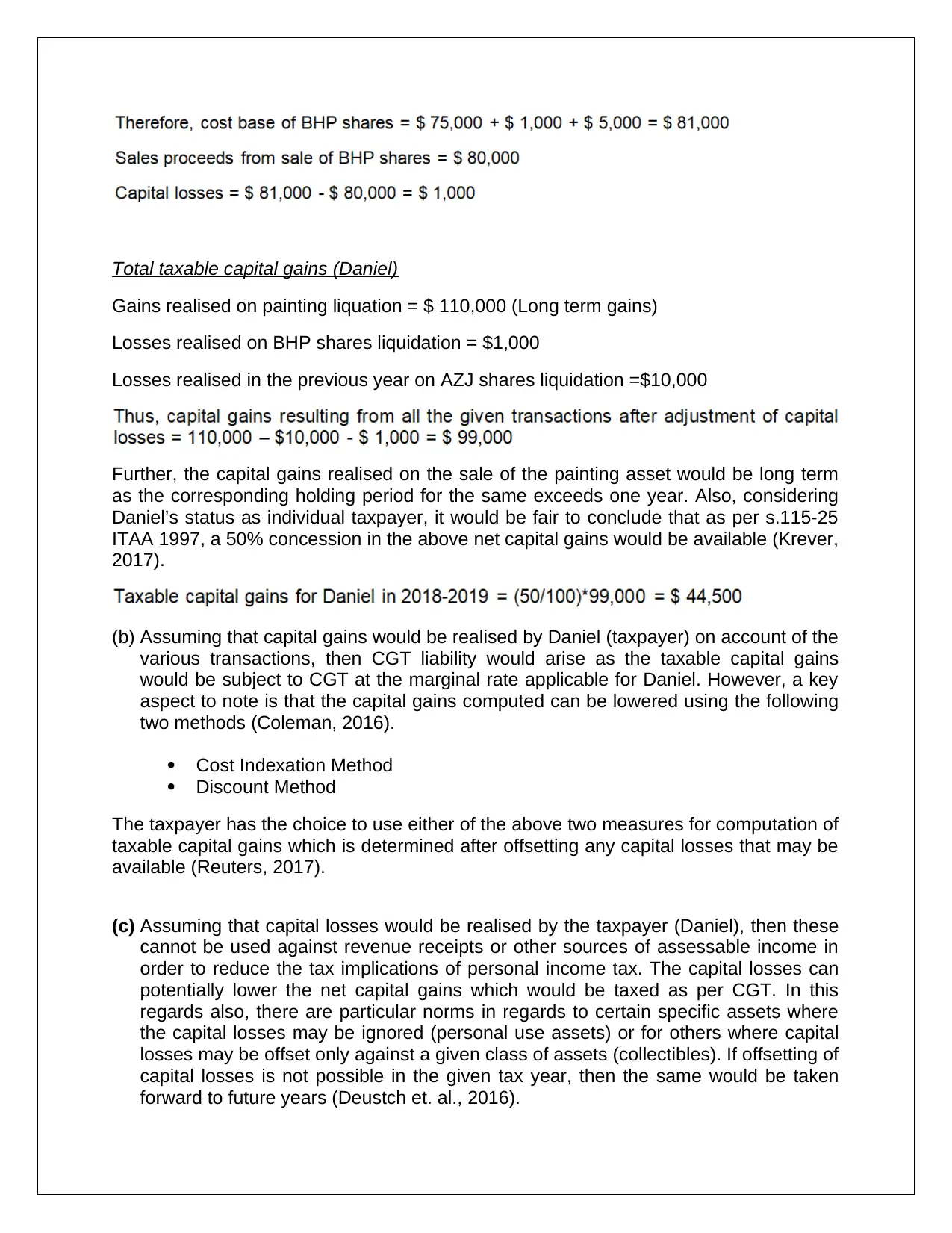
Total taxable capital gains (Daniel)
Gains realised on painting liquation = $ 110,000 (Long term gains)
Losses realised on BHP shares liquidation = $1,000
Losses realised in the previous year on AZJ shares liquidation =$10,000
Further, the capital gains realised on the sale of the painting asset would be long term
as the corresponding holding period for the same exceeds one year. Also, considering
Daniel’s status as individual taxpayer, it would be fair to conclude that as per s.115-25
ITAA 1997, a 50% concession in the above net capital gains would be available (Krever,
2017).
(b) Assuming that capital gains would be realised by Daniel (taxpayer) on account of the
various transactions, then CGT liability would arise as the taxable capital gains
would be subject to CGT at the marginal rate applicable for Daniel. However, a key
aspect to note is that the capital gains computed can be lowered using the following
two methods (Coleman, 2016).
Cost Indexation Method
Discount Method
The taxpayer has the choice to use either of the above two measures for computation of
taxable capital gains which is determined after offsetting any capital losses that may be
available (Reuters, 2017).
(c) Assuming that capital losses would be realised by the taxpayer (Daniel), then these
cannot be used against revenue receipts or other sources of assessable income in
order to reduce the tax implications of personal income tax. The capital losses can
potentially lower the net capital gains which would be taxed as per CGT. In this
regards also, there are particular norms in regards to certain specific assets where
the capital losses may be ignored (personal use assets) or for others where capital
losses may be offset only against a given class of assets (collectibles). If offsetting of
capital losses is not possible in the given tax year, then the same would be taken
forward to future years (Deustch et. al., 2016).
Gains realised on painting liquation = $ 110,000 (Long term gains)
Losses realised on BHP shares liquidation = $1,000
Losses realised in the previous year on AZJ shares liquidation =$10,000
Further, the capital gains realised on the sale of the painting asset would be long term
as the corresponding holding period for the same exceeds one year. Also, considering
Daniel’s status as individual taxpayer, it would be fair to conclude that as per s.115-25
ITAA 1997, a 50% concession in the above net capital gains would be available (Krever,
2017).
(b) Assuming that capital gains would be realised by Daniel (taxpayer) on account of the
various transactions, then CGT liability would arise as the taxable capital gains
would be subject to CGT at the marginal rate applicable for Daniel. However, a key
aspect to note is that the capital gains computed can be lowered using the following
two methods (Coleman, 2016).
Cost Indexation Method
Discount Method
The taxpayer has the choice to use either of the above two measures for computation of
taxable capital gains which is determined after offsetting any capital losses that may be
available (Reuters, 2017).
(c) Assuming that capital losses would be realised by the taxpayer (Daniel), then these
cannot be used against revenue receipts or other sources of assessable income in
order to reduce the tax implications of personal income tax. The capital losses can
potentially lower the net capital gains which would be taxed as per CGT. In this
regards also, there are particular norms in regards to certain specific assets where
the capital losses may be ignored (personal use assets) or for others where capital
losses may be offset only against a given class of assets (collectibles). If offsetting of
capital losses is not possible in the given tax year, then the same would be taken
forward to future years (Deustch et. al., 2016).
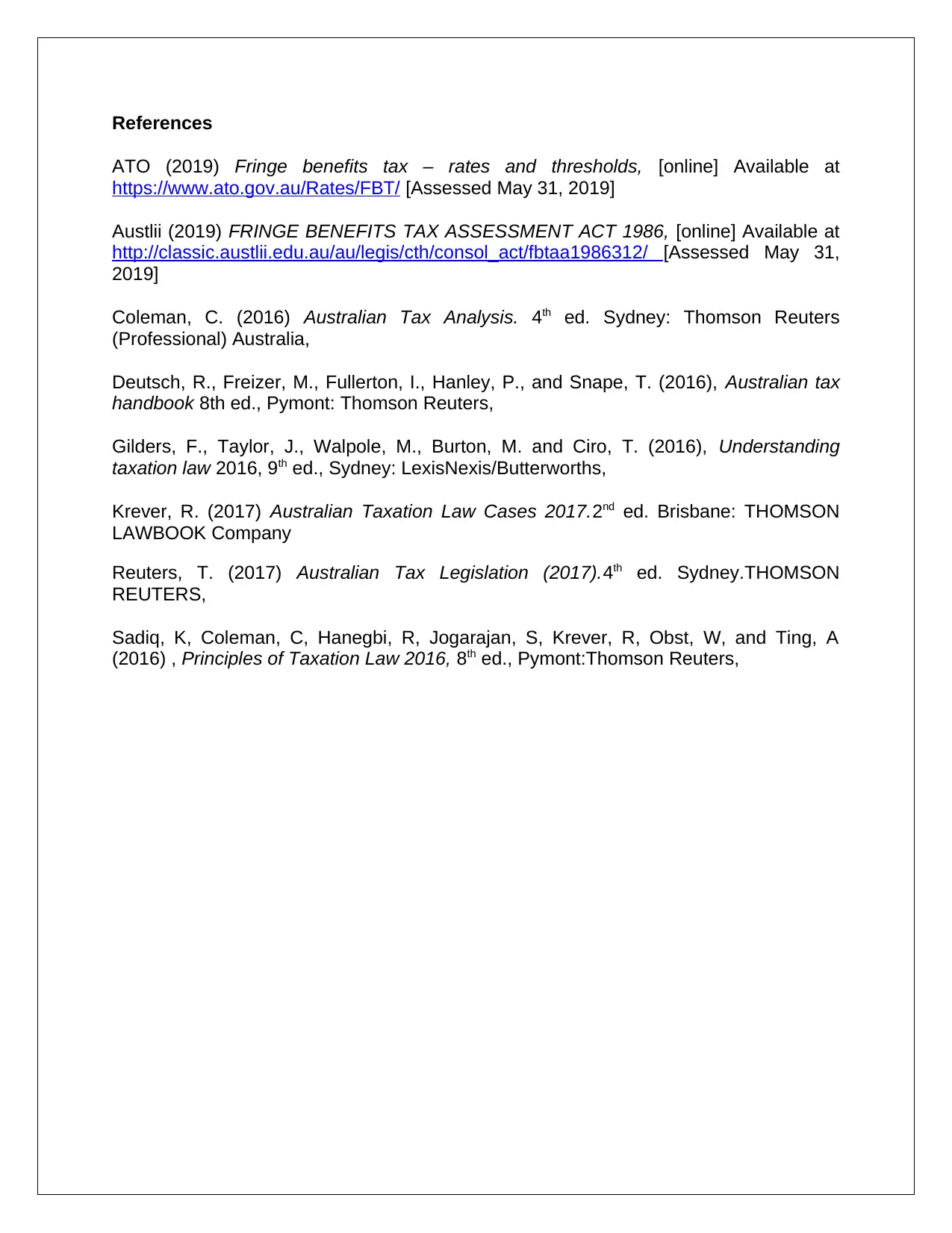
References
ATO (2019) Fringe benefits tax – rates and thresholds, [online] Available at
https://www.ato.gov.au/Rates/FBT/ [Assessed May 31, 2019]
Austlii (2019) FRINGE BENEFITS TAX ASSESSMENT ACT 1986, [online] Available at
http://classic.austlii.edu.au/au/legis/cth/consol_act/fbtaa1986312/ [Assessed May 31,
2019]
Coleman, C. (2016) Australian Tax Analysis. 4th ed. Sydney: Thomson Reuters
(Professional) Australia,
Deutsch, R., Freizer, M., Fullerton, I., Hanley, P., and Snape, T. (2016), Australian tax
handbook 8th ed., Pymont: Thomson Reuters,
Gilders, F., Taylor, J., Walpole, M., Burton, M. and Ciro, T. (2016), Understanding
taxation law 2016, 9th ed., Sydney: LexisNexis/Butterworths,
Krever, R. (2017) Australian Taxation Law Cases 2017.2nd ed. Brisbane: THOMSON
LAWBOOK Company
Reuters, T. (2017) Australian Tax Legislation (2017).4th ed. Sydney.THOMSON
REUTERS,
Sadiq, K, Coleman, C, Hanegbi, R, Jogarajan, S, Krever, R, Obst, W, and Ting, A
(2016) , Principles of Taxation Law 2016, 8th ed., Pymont:Thomson Reuters,
ATO (2019) Fringe benefits tax – rates and thresholds, [online] Available at
https://www.ato.gov.au/Rates/FBT/ [Assessed May 31, 2019]
Austlii (2019) FRINGE BENEFITS TAX ASSESSMENT ACT 1986, [online] Available at
http://classic.austlii.edu.au/au/legis/cth/consol_act/fbtaa1986312/ [Assessed May 31,
2019]
Coleman, C. (2016) Australian Tax Analysis. 4th ed. Sydney: Thomson Reuters
(Professional) Australia,
Deutsch, R., Freizer, M., Fullerton, I., Hanley, P., and Snape, T. (2016), Australian tax
handbook 8th ed., Pymont: Thomson Reuters,
Gilders, F., Taylor, J., Walpole, M., Burton, M. and Ciro, T. (2016), Understanding
taxation law 2016, 9th ed., Sydney: LexisNexis/Butterworths,
Krever, R. (2017) Australian Taxation Law Cases 2017.2nd ed. Brisbane: THOMSON
LAWBOOK Company
Reuters, T. (2017) Australian Tax Legislation (2017).4th ed. Sydney.THOMSON
REUTERS,
Sadiq, K, Coleman, C, Hanegbi, R, Jogarajan, S, Krever, R, Obst, W, and Ting, A
(2016) , Principles of Taxation Law 2016, 8th ed., Pymont:Thomson Reuters,
⊘ This is a preview!⊘
Do you want full access?
Subscribe today to unlock all pages.

Trusted by 1+ million students worldwide
1 out of 9
Related Documents
Your All-in-One AI-Powered Toolkit for Academic Success.
+13062052269
info@desklib.com
Available 24*7 on WhatsApp / Email
![[object Object]](/_next/static/media/star-bottom.7253800d.svg)
Unlock your academic potential
Copyright © 2020–2025 A2Z Services. All Rights Reserved. Developed and managed by ZUCOL.




